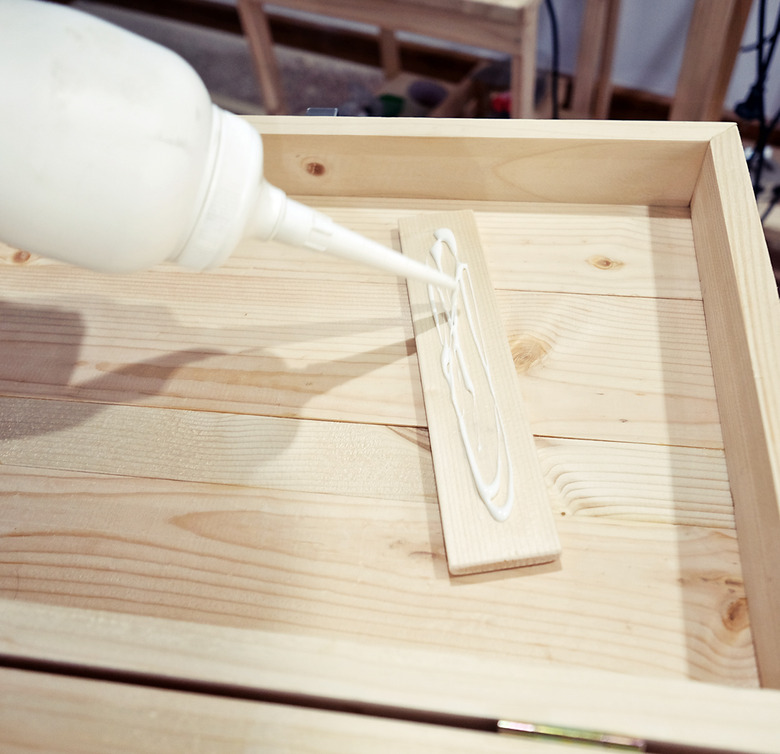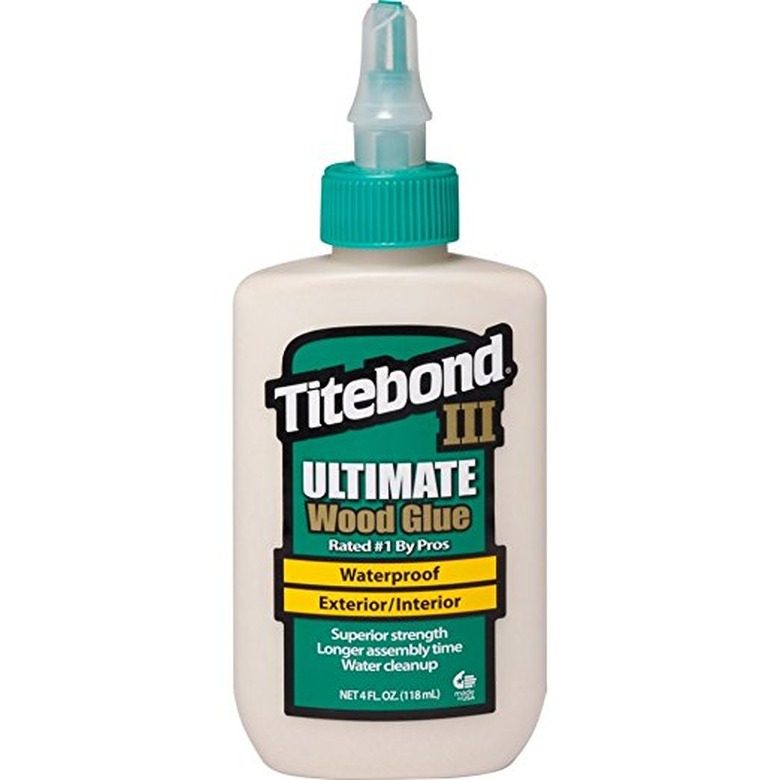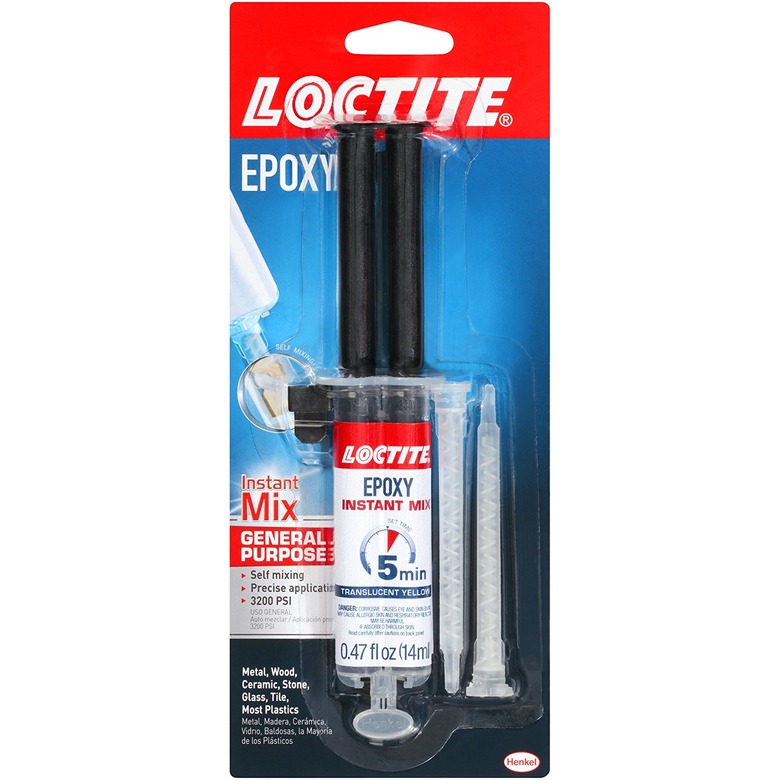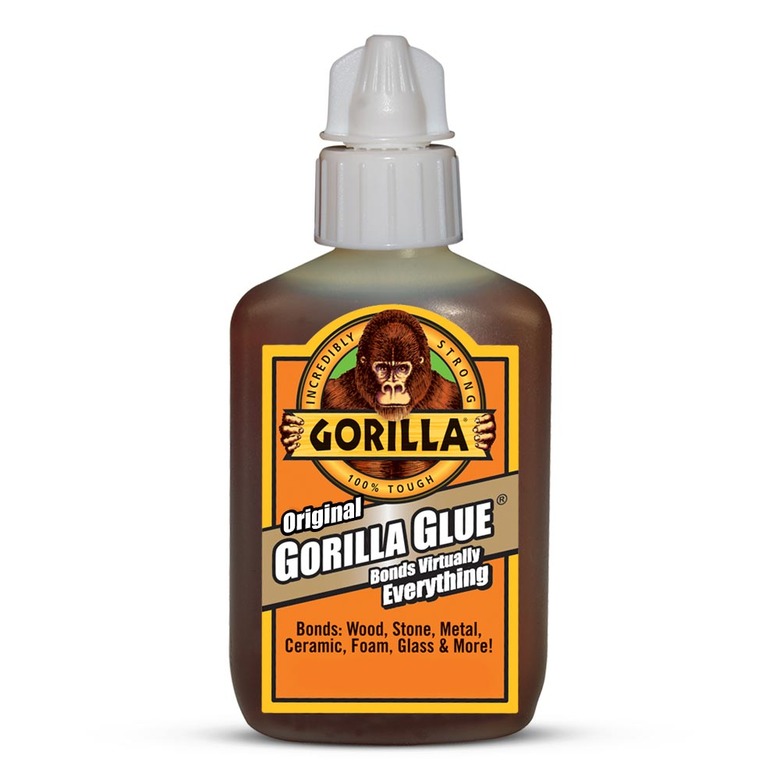A Homeowner's Guide To Glues And Adhesives
Many of us grew up in households that relied on two types of glue for virtually all repairs: superglue for broken mugs and plastic items, and Elmer's School Glue for pretty much everything else. And before that, there was just one all-purpose household glue: rubber cement. But as handy as these old standbys are, they really aren't chemically designed to bond to all of the materials we'd like (or hope) them to. That doesn't mean you should get rid of these old standards, but it does mean that no single glue is good for everything. So by all means, keep those old favorites in your adhesive arsenal, but also add a few more so you don't get stuck with the wrong glue when your next repair project comes up.
White Glue
White Glue
Everyone knows Elmer's glue, but not everyone knows it's a type of polyvinyl acetate, or PVA, glue. White glue is about half water, and it cures as the water evaporates while the vinyl polymer strands in the glue bond together. White glue is a good all-purpose craft glue and sticks best to paper and wood. However, it yellows over time and even loses its grip, so it's not a good choice for furniture projects or important pieces that you want to look good and stay together for posterity. White glue cleans up easily with water.
Wood Glue
Wood Glue
Wood glue is another type of PVA glue (like white glue), and some formulas are little more than a yellow version of standard white glue. The differences with quality wood glues are that they last longer than white glue and some are formulated to be waterproof once they are fully cured. There are no bonding performance differences among water-resistant, non-water-resistant and waterproof wood glues, so it makes sense to have one bottle of waterproof wood glue on hand and use it for all wood projects. And don't forget to clamp the pieces together for at least 30 minutes for maximum strength. Wood glue, like white glue, cleans up with water, or you can let excess glue dry and scrape it off with a chisel.
Superglue
Superglue
Superglue, or instant glue, is technically called cyanoacrylate (CA)—and, yes, it's capable of supporting a grown man who's glued his hardhat to a construction beam (as in the old TV commercials). But the truth is that a lot of common adhesives are strong enough to do that. The key difference is that most adhesives take longer to dry than instant glue's 30-second setting time (note that a full cure on instant glue takes 24 hours). The primary advantages of CA glue, apart from the quick setting time, are that it's thin, clear and waterproof, making it ideal for glass, ceramics, china and other materials where a thick or visible glue joint is undesirable.
On the downside, CA glue is brittle and lacks impact resistance, so it's not a good choice for structural joints. And, much to the vexation of many homeowners, it's very hit-or-miss as to what it really sticks to. You'll get the best results with clean, tight-fitting joints; apply the glue sparingly, and don't move the parts even the tiniest amount once you stick them together—for at least a few minutes. If the glue doesn't hold at that point, try a different adhesive. Superglue now comes in thicker "gel" versions, but these also require very tight-fitting joints for a bond. They don't fill gaps any better than standard superglue.
Superglue can be dissolved with acetone (nail polish remover) before it cures, but it is much more difficult to remove after it cures.
Epoxy
Epoxy
If you're faced with a heavy-duty gluing task and your first thought is "superglue," your second thought probably should be "epoxy." Two-part epoxy contains a hardener and a catalyst that are mixed by hand (with a little stick or toothpick) or inside a syringe-type package just before application. The chemical reaction between the two parts makes the glue stick to almost any surface (wood, metal, glass, plastic, you name it) and cure into a hard, clear-ish plastic.
Epoxy is thick and gooey, making it excellent for filling gaps between materials. It's also very strong and impact-resistant. If you have any doubts about other glues holding in a given situation, try epoxy. Epoxy on your skin can be removed with vinegar, acetone or citrus-based hand cleansers. Cured epoxy on materials (not skin) can be softened with denatured alcohol, paint thinner or 200° F heat from a heat gun.
Polyurethane Glue
Polyurethane Glue
Polyurethane glue fills an important niche for builders and handy folks. It sticks as well as epoxy to wood, metal, glass, plastic, masonry and many other materials, and it can be used in place of epoxy in many situations. But it's even more useful for wood joints because it expands as it cures and can turn a loose-fitting old furniture joint into a rock-solid connection. And unlike epoxy, it takes paint and stain relatively well.
Polyurethane glue cures with moisture (you have to moisten the mating parts) and is incredibly strong. It cleans up with solvents, such as acetone or denatured alcohol. Once dried, blobs of the glue scrape off easily with a chisel but they will leave behind a yellowish residue that you can tackle with solvent, if necessary.
It's good to keep a bottle of this high-tech "super" glue around, especially for fixing old furniture, but use it with caution. It bubbles and foams up out of joints as it sets, so be careful not to apply too much. If you get in on your fingers, it'll stain them brown for a few days. And if you get it on anything else, you might just have to live with it.
Construction Adhesive
Construction Adhesive
Sold in tubes for caulk guns and in smaller squeeze tubes, construction adhesive is best known by the brand name Liquid Nails. Builders use construction adhesive to glue wood framing to concrete slabs and walls, secure subflooring to floor joists (so it doesn't move and squeak), fasten drywall and panels to support structures, and glue a wide range of materials together. Construction adhesive is a little thicker than toothpaste and is easy to apply, but it's ugly and extremely hard to remove when dry. Use it only for heavy-duty connections that are hidden or where appearance isn't a factor. You can remove construction adhesive from your skin with petroleum jelly or with mineral or vegetable oil. If you need to separate two materials glued with construction adhesive, one leading manufacturer recommends cutting through the glue with piano wire (no joke).
Hot Glue
Hot Glue
Hot glue is the crafter's go-to adhesive. It comes in cylindrical sticks of translucent plastic and is applied with an electric hot glue gun that melts the glue as you apply it. Once applied, the glue cools and reverts to its hard plastic state, adhering to whatever it touches. The magical process comes from the glue's blend of polymers, resins and wax. It is a thermoplastic adhesive, meaning that it liquifies and solidifies with the addition and removal of heat. Hot glue sticks to most household materials, provided they are clean and dry. Standard types are not waterproof and not very heat-proof once dried. To remove hot glue, simply peel it off of the surface—it comes off of most hard surfaces without a trace but can get stuck in porous materials, such as fabric. The bond strength of hot glue varies widely and should be considered semi-permanent; if you stress a glued joint, it will come apart.
Contact Adhesives
Contact Adhesives
Contact adhesives are sprayed or rolled onto a surface and allowed to set so they are merely tacky to the touch. The glued surface can then be pressed onto another material to create a bond. Spray adhesive is another crafter's favorite (along with hot glue). It's ideal for adhering paper, fabric, cardboard, photos, etc. to a variety of backing surfaces. If you spray only one of the materials to be bonded, the adhesive allows you a limited time in which to reposition the materials. If you spray both pieces with glue, they won't be repositionable, and the permanent bond will be stronger.
The industrial-grade version of contact adhesive is contact cement. This is a smelly, fume-producing liquid sold in metal cans. You roll the adhesive onto both surfaces to be joined, using a foam paint roller, and allow the surfaces to set until they're no longer sticky. When you press the two glued surfaces together, they form an instant, very strong bond that only gets stronger the more you press the pieces together. Around the house, contact cement is used for one thing: plastic laminate countertops. It's the best glue for adhering the plastic laminate to particleboard to form the countertop material.



